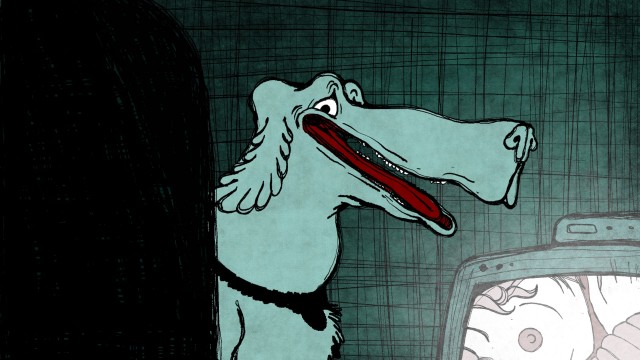Scratchy and loud, Lola Lefèvre’s animated short film Maman, il a quoi le chien? (Mom, What’s Up With the Dog?) unleashes the primal gestures of puberty through a young lead, Gwen, discovering her sexuality for the first time. With style and form as a guiding force, the viewer, like Gwen and her dog, feel animalistically curious and somehow easily uneasy. Anxious in its dark lines and incongruent pacing, Lefèvre does a stellar job communicating exactly what she sets out to, which is a (semi-inseparable) crosshair between nightmare and coming of age.
Discussing the inspiration behind the film, Lefèvre reveals that the image of a laughing dog first came to her during a bout of insomnia in her 2nd year at animation school Atelier de Sevres. Instantly recognizing that she “wanted to make something out of this idea”, the director decided to “save it for later” and instead focused on making “a film about a young girl discovering her sexuality”. However, a conversation with a fellow filmmaker soon had her considering the idea of blending these two concepts, as she explains:
A scriptwriter suggested that I combine the two protagonists: the young girl and the laughing dog. At first glance, it felt a bit weird and absurd to me. I tried to dig a bit more into it by searching on the internet for the definition of laughing. I found out about this book dealing with the evolution of the perception of women’s laughter throughout ages. There was this bit of one chapter that described the pure and honest laughter of women as something bestial and dirty, directly linked to freedom and sexuality. The connection between my two protagonists suddenly became obvious in my head and I started to write the script.”
The film doesn’t revolve so much around dialogue as it does this object/theme/nightmare, DOG whom we laugh at yet also dually understand as a figure for much more. Puberty, laughter, and the stigma/history of women’s pleasure, the topics Lefèvre introduces brilliantly through this long nosed laughing hound will linger in your head far beyond the film’s duration.

A laugh can be the scariest expression a face can give, but when a dog laughs, what does that mean? Here the dog wants to f*ck a cauliflower and so so does Gwen. Essentially, Gwen wants to be her dog: she wants to be free. Reflecting on my own past, that desire for freedom is very relatable and Lefèvre’s film takes your hand and guides you through these emotions, acknowledging them without passing judgment. It confronts the quiet, concealed discomfort of female puberty, bringing it to the forefront with remarkable clarity and beauty, even amidst its perceived ugliness.
To translate Gwen’s tensions to the screen, Lefèvre illustrates in a dark, sketchy, and liminal way, with the vibe of the film very much carried by this distinct style. Inspired by artists such as Egon Schiele and Bernard Buffet, the director explains that their paintings displayed “an intense and loud atmosphere”, which Lefèvre was “very connected to”. The recognition that a “form of gravity and heaviness was visible both on the human characters and the backgrounds” would prove influential in the aesthetic of the short. With the filmmaker revealing that they wanted to portray something “raw and brutally honest”, just like how the physical appearance of Gwen is shaped by the early stages of puberty, as she transforms from “a cute little girl with messy hair to a hairy greasy creature”.
Raw feels like an apt description here, perfectly capturing what Lefèvre is able to convey, through the imagery and storyline, in the film’s brief seven-minute duration. Maman, il a quoi le chien? is part of the Miyu Distribution catalog and it’s easy to see what attracted them to both the short and the director’s emerging talents.
